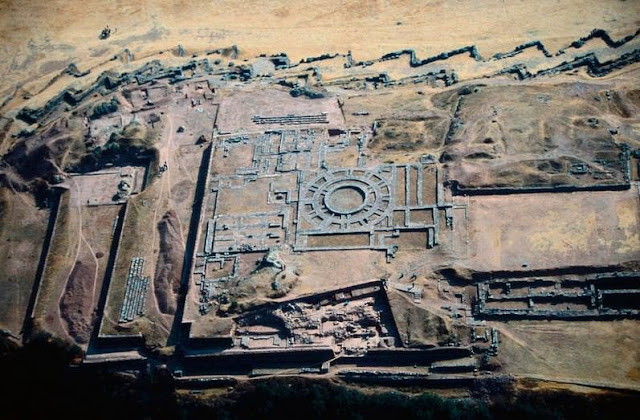Saksaywaman, Sasawaman, Saksawaman, Sasaywaman,
Saqsaywaman or Saksaq Waman is a walled complex on the northern outskirts of the
city of Cusco, Peru, the former capital of the Inca Empire. Like other Pre-Inca
constructions, the complex is made of large polished dry stone walls with
boulders carefully cut to fit together tightly without mortar.
Sachsayhuaman
sits at an altitude of 3,701 meters above sealevel and is part of the city of
Cusco in Peru.
M
Video Source: Brien
Foerster
http://www.youtube.com/watch?v=ctPDMwomsQQ
Located on a
steep hill that overlooks the city, Sachsayhuaman contains an impressive view
of the valley to the southeast. Surface collections of pottery at Saksaywaman
indicate that occupation of the hill top dates back at least a millennium.
However recent theories point to the construction being thousands of years
older due to their similar construction of megalithic stone building’s found
around the World.

Because of its
location high above Cusco and its immense terrace walls, this area of
Saksaywaman is frequently referred to as a fortress.
Video Source:
Brien Foerster
http://www.youtube.com/watch?v=8FtB7Bjxr7w
The importance of
its military functions was highlighted in 1536 when Manco Inca
lay siege to Cusco. Much of the fighting occurred in and around Saksaywaman as
it was critical for maintaining control over the city. It is clear from
descriptions of the siege, as well as from excavations at the site, that there
were towers on its summit as well as a series of other buildings. For example Pedro Sancho, who visited the
complex before the siege, mentions the labyrinth-like quality of the complex
and the fact that it held a great number of storage rooms filled with a wide
variety of items. He also notes that there were buildings with large windows
that looked over the city. These structures, like so much of the site, have
long since been destroyed.
The best-known
zone of Saksaywaman includes its great plaza and its adjacent three massive
terrace walls. The stones used in the construction of these terraces are among
the largest used in any building in prehispanic America and display a precision
of fitting that is unmatched in the Americas. The stones are so closely spaced
that a single piece of paper will not fit between many of the stones. This
precision, combined with the rounded corners of the blocks, the variety of
their interlocking shapes, and the way the walls lean inward, is thought to
have helped the ruins survive devastating earthquakes in Cuzco. It is believed
by many that they were built precisely to survive earthquakes.
The longest of
three walls is about 400 meters. They are about 6 meters tall. The estimated
volume of stone is over 6,000 cubic meters. Estimates for the weight of the largest
Andesite block vary from 128 tonnes to almost 200 tonnes.
Video Source:
Brien Foerster
http://www.youtube.com/watch?v=mRI0VQoxkiI
Following the
siege of Cuzco, the Spaniards began to use Saksaywaman as a source of stones
for building Spanish Cuzco and within a few years much of the complex was
demolished. The site was destroyed block-by-block to build the new governmental
and religious buildings of the city, as well as the houses of the wealthiest
Spaniards. In the words of Garcilaso de la Vega (1966:471 [1609: Part 1, Book.
Bk. 7, Ch. 29]): "to save themselves the expense, effort and delay with
which the Indians worked the stone, they pulled down all the smooth masonry in
the walls. There is indeed not a house in the city that has not been made of
this stone, or at least the houses built by the Spaniards." Today, only
the stones that were too large to be easily moved remain at the site.
-------------------------------
Visit Brien Foerster at the following websites:
Brien Foerster – Official Website
http://hiddenincatours.com/Brien Foerster - YouTube
http://www.youtube.com/user/brienfoerster
Brien Foerster - Facebook
https://www.facebook.com/Shipibospirit

Sideways view of the walls of Saksaywaman showing the details of the stonework and the angle of the walls.

No comments:
Post a Comment
I'll be right with you. 8O)